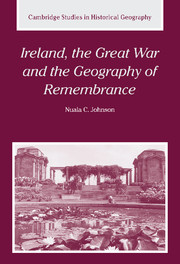Book contents
- Frontmatter
- Contents
- List of illustrations
- Acknowledgements
- 1 Geography, landscape and memory
- 2 A call to arms: recruitment poster and propaganda
- 3 Parading memory: peace day celebrations
- 4 Sculpting memory: space, memorials and rituals of remembrance
- 5 Scripting memory: literary landscapes and the war experience
- 6 Remembering the Easter Rebellion 1916
- 7 Conclusion
- Bibliography
- Index
- Cambridge Studies in Historical Geography
3 - Parading memory: peace day celebrations
Published online by Cambridge University Press: 15 July 2009
- Frontmatter
- Contents
- List of illustrations
- Acknowledgements
- 1 Geography, landscape and memory
- 2 A call to arms: recruitment poster and propaganda
- 3 Parading memory: peace day celebrations
- 4 Sculpting memory: space, memorials and rituals of remembrance
- 5 Scripting memory: literary landscapes and the war experience
- 6 Remembering the Easter Rebellion 1916
- 7 Conclusion
- Bibliography
- Index
- Cambridge Studies in Historical Geography
Summary
Life springs from death; and from the graves of patriot men and women spring living nations
This extract from Patrick Pearse's renowned oration of 1915 at the graveside of the Fenian, Jeremiah O'Donovan Rossa, reminds us of the powerful political and symbolic role of public commemoration in the politics of everyday life in early twentieth-century Ireland. The previous century had provided several important precedents for commemorating the death of political leaders as the funerals of O'Connell, Parnell and MacManus testify. Commemoration, however, was not confined to individual leaders. The politics of memory generated by the centenary celebrations of the 1798 rebellion, represented through the fusion of the heroic priest-leader and the archetypal peasant in public statuary, illustrates that collective memory could also be aroused through the remembrance of an anonymous rebel soldier. As Whelan puts it, in his examination of official and popular readings of the rebellion, ‘besides its Catholic-nationalist reading, the centenary was pivotal in knitting together the strands of nationalist opinion which had unravelled in the acrimonious aftermath of the Parnell split’.
Over two decades later, commemorating the dead who served in Irish regiments in the First World War would similarly challenge cultural allegiances in Ireland, both in nationalist and unionist quarters. The peace parades of July 1919 established the initial framework for commemoration. The public spectacle staged in cities and towns around the country in 1919 provides insights into how the war was calibrated in the popular imagination at a moment when the Home Rule crisis was not yet resolved and the Easter rebellion of 1916 was fresh in the public's memory.
- Type
- Chapter
- Information
- Ireland, the Great War and the Geography of Remembrance , pp. 56 - 79Publisher: Cambridge University PressPrint publication year: 2003



